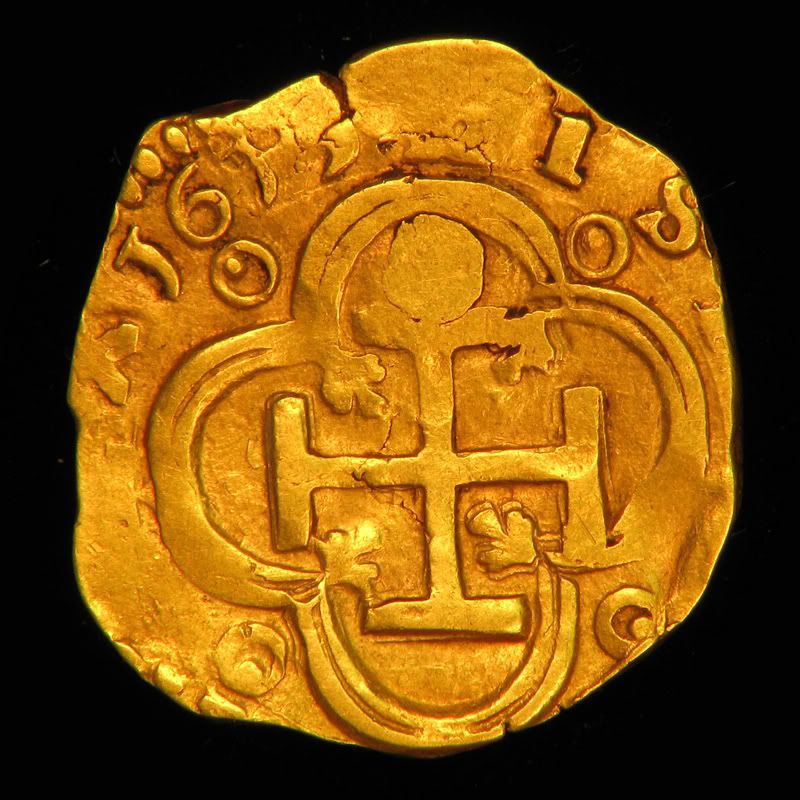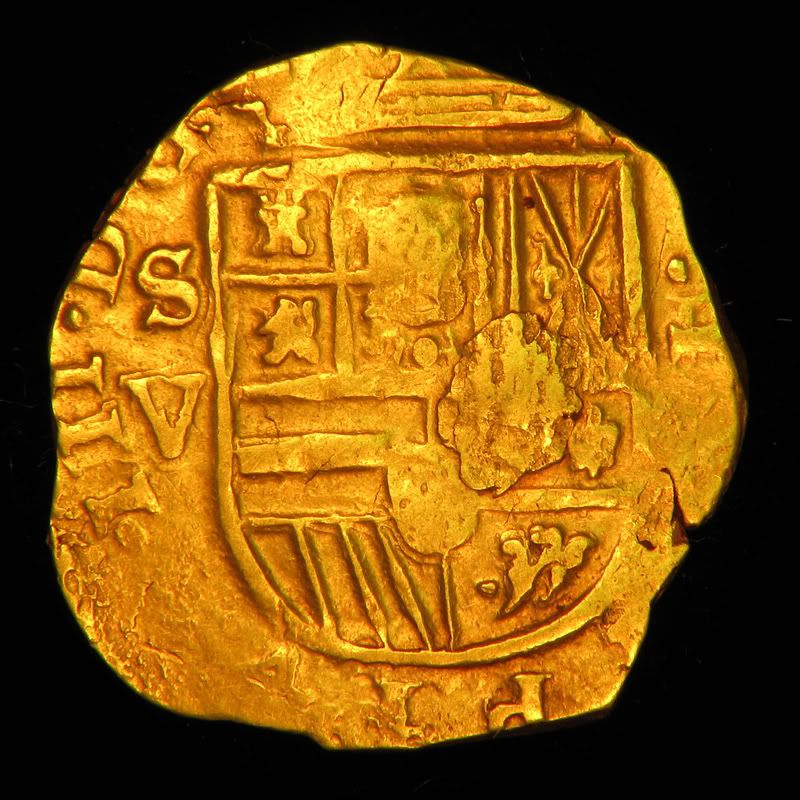Options
Believe it or not, this is a liteside coin...
 Regulated
Posts: 2,994 ✭✭✭✭✭
Regulated
Posts: 2,994 ✭✭✭✭✭
Regulated to $3 2/3 according to Continental Congress, September 2, 1776:


I've been trying to figure this one out for a while, and the answer was right under my nose!


I've been trying to figure this one out for a while, and the answer was right under my nose!
What is now proved was once only imagined. - William Blake
0
Comments
Awesome piece of gold you have there
As to whether it's considered Liteside, or not - hard to say. It was authorized for circulation, however not minted specifically for the colonies.
There have been some discussion on U.S. boards, that I've been trying to fuel
Link 1
8 Reales Madness Collection
Really, when you get right down to it, the definition of "Liteside" coin is pretty broad prior to 1792. (Really, prior to 1857. We detectorists sometimes tend to find a little bit more Spanish colonial silver on early sites around here than we do pre-Civil War US coins).
The plug brought the coin to the US standard. I'd call it Liteside. Very cool, too!
Doggedly collecting coins of the Central American Republic.
Visit the Society of US Pattern Collectors at USPatterns.com.
Doggedly collecting coins of the Central American Republic.
Visit the Society of US Pattern Collectors at USPatterns.com.
<< <i>We detectorists sometimes tend to find a little bit more Spanish colonial silver on early sites around here than we do pre-Civil War US coins). >>
...which tells us something about what we would find merchants' tills in early America if we could travel back to those times and have a look.
Lots of coins from mints in Mexico City and Potosi. Maybe even an occasional coin from some minor mint in Philadelphia.
"The Central Intelligence Agency owns everyone of any significance in the major media" - William Colby, former CIA director
It was an incredible hodgepodge- had to have been. British, Spanish, French, Dutch, and Portuguese coins, just to name a few. Tokens. Counterfeits.
I suspect if it was round and metallic, our founding fathers would've spent it.
On one site, in one area, I dug a 1782 French colonial 2-sous piece struck for the Colony of Cayenne, within a few feet of it, a contemporary counterfeit Irish 1782 "Hibernia" halfpenny, and then, maybe a hundred yards away or so, a 1779 Spanish colonial 2-reales piece struck in Mexico City.
French, British, and Spanish colonial all on one site. I call these coins the "Colonial Trio".
If that doesn't speak for the eclectic mixture in circulation in the late 1700s and early 1800s, I don't know what does.
The site was a plantation active since the Revolution, on the northern end of St. Simons Island, GA. Known as Hampton Point, it is a historic spot. The sternpost for the USS Constitution was made from a giant live oak cut on the site. And Aaron Burr was a guest in the house after the infamous duel that killed Alexander Hamilton in 1804. For all I know, those coins could have come out of his pocket.
I also got the nicest Standing Liberty quarter I've ever dug, on the same site. It was a sharp 1929, no doubt lost by some other visitor who was wandering the tabby ruins like I was. I briefly had permission to hunt adjacent to the house site, while a modern house was being built there. It's mostly multimillion-dollar modern homes there on the riverbank, now.
(Sorry for the old, small, crap scans. I gotta upgrade my detector album with proper photos. I'm tryin'.)
(SLQ pic included just because it was found there, too.)
... and that was just one site.
And these are just the coins I have pictures of...
Too bad I didn't carry a camera with me on my hunts back then, or write a detecting blog like I do now. (I didn't get online until late 1999).
Now that I do carry a camera, and do make detailed blog entries, I don't seem to find this kind of stuff anymore.
Continental Congress set the weight of Spanish Pistoles at 4 DWT 8 Gr (104 Grains). They valued fine gold at 24.75 Grains to the dollar, so I would have to guess that they assumed the fineness of Spanish Gold to be around .875. To wit:
104 X .875 = 91 Grains fine gold
91 / 24.75 = 3.67 (roughly $3 2/3)
What is now proved was once only imagined. - William Blake
I presume this means that pistoles weighing less than 104 grains were not valid for commerce. In other words, the law set a minimum weight at which Pistoles would be valid in the US, and if that weight, the value would be $3 2/3. Correct?
Doggedly collecting coins of the Central American Republic.
Visit the Society of US Pattern Collectors at USPatterns.com.
More or less, in practice, underweight pieces passed at a lower rate - generally 3 or 4 pence per grain deficient.
What is now proved was once only imagined. - William Blake
David - In practice, do you think regulated gold would be weighed before it was accepted? After all, the coin could have been clipped after being regulated, or it could have been regulated improperly to begin with. Along the same lines, have you seen contemporary reports of underweight regulated pieces? And for that matter, do you know of any such underweight pieces still in existence?
Doggedly collecting coins of the Central American Republic.
Visit the Society of US Pattern Collectors at USPatterns.com.
I think that regulated gold in regular circulation would probably have been weighed frequently - I suspect that most of the transactions where it wouldn't have been weighed would have been between merchants or banks that did business in large quantities, where the item would be weighed once and would pass into the system - I do know that following a transaction, banks would often check individual pieces, returning them with questions to their source - the Brasher Doubloon letters between Alexander Hamilton and the Bank of New York deal with a situation of this sort.
I also know of regulated pieces that have low grade gold in the plugs, thereby throwing the values off, and I have regulated pieces that were clipped down and had a counterfeit edge put on them, ostensibly to fool people into assuming that they were full weight. Obviously, the system was far from perfect.
What is now proved was once only imagined. - William Blake
These were essentially numbers that made for easy lowest-common-denominator calculations among the various state/colony valuations. In sterling (i.e. British pounds, shillings and pence, which should NOT be confused with NY L.s.d or CT L.s.d, etc.), a Spanish dollar was 4s6d. This meant that $2/3 of a dollar was 3 shillings -- a nice, neat sum.
But when you look at North American L.s.d. values, it makes even more sense. Most states set the value of a Spanish dollar at 7s6d in local money of account, i.e. Pennsylvania pounds. Remember that Pennsylvania pounds had as much to do with English pounds as US dollars have to do with Australian dollars -- they share nothing but a name.
2/3 of a Pennsylvania dollar (7s6d) is 5 shillings -- or one crown!
$3 2/3 in Pennsylvania L.s.d is 27s6d, or 20 shillings plus 7s6d (a dollar) ... or one PA pound and one dollar.
In Connecticut, where a dollar was 6s in local money of account, $3 2/3 was 22 shillings, or a pound and 2 shillings.
In Georgia, the dollar was pegged at 5 shillings. Thus $3 2/3 was 18 shillings, 4 pence, or a crown and $2/3 of a dollar.
It is no concidence that many states (Maryland, Georgia, New York, Virginia) had bills in the $2/3 denomination while others (CT, MA, NJ, PA) had bills in L.s.d denominations that equalled $2/3 in the local money of account.
As ridiculously complex as these tabulations seem to us, this is what colonial kids learned in math class (look at the textbooks of the era -- this is what their word problems looked like).
Betts medals, colonial coins, US Mint medals, foreign coins found in early America, and other numismatic Americana
Thank you for the photo. That is a piece worthy of the Smithsonian. whew!
Betts medals, colonial coins, US Mint medals, foreign coins found in early America, and other numismatic Americana
Very interesting topic!
Collecting:
Conder tokens
19th & 20th Century coins from Great Britain and the Realm
What is now proved was once only imagined. - William Blake
Betts medals, colonial coins, US Mint medals, foreign coins found in early America, and other numismatic Americana